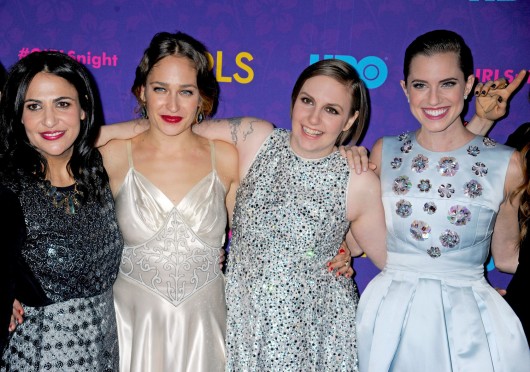
Jenni Konner (left), Jemima Kirke, Lena Dunham and Allison Williams attend the premiere of ‘Girls’ Season 3, held at Jazz at Lincoln Center in New York City Jan. 6.
Credit: Courtesy of MCT
Perhaps Venus has been rebirthed or Olympia has been recalled from her bed, but the topic of female nudity is making a comeback centuries after Botticelli and Manet trended it.
Sunday marked the beginning of the third season of HBO’s post-recession “Sex and the City”-esque show, “Girls,” and the media has been working endless hours to revisit the question and function of Lena Dunham, the show’s writer, producer and creator, as well as star, exposing her bare body on television more than once and longer than two seconds per take.
One brave reporter dared to ask Dunham why the show’s characters were constantly naked during a panel at the Television Critics Association winter press tour.
“I don’t get the purpose of the nudity on the show, by you (Dunham) particularly and I feel like I’m walking into a trap where you go, ‘Nobody complains about the nudity on “Game of Thrones,” but I get why they are doing it,’” said Tim Molloy, a writer for The Wrap. “They (‘Game of Thrones’) are doing it to be salacious and, you know, titillate people. And your character is often naked just at random times for no reason.”
It’s important to identify a discrepancy in Molloy’s posed question, claiming Dunham’s character is often naked for no reason.
BuzzFeed writer Louis Peitzman took inventory of all the nudity scenes among the last two seasons of “Girls.” His findings reported that among the 3 percent of the time characters of the show were au naturale, 74 percent of the time, the character was female, and 64 percent of the time it was, in fact, Dunham’s character.
However, the cause for the nakedness were reasons in which women in everyday life choose to be naked. Almost 50 percent of the time, “Girls’” nudity was in the context of sexual activity, while another roughly 11 percent was in the context of bathing, peeing or going to bed.
Now that the first part of Molloy’s question is nearly debunked, it’s best to examine the true nature of his inquiry.
Molloy understands the nudity of HBO’s other hit show, “Game of Thrones.” It’s salacious. It’s titillating.
Translation: He does not find Dunham’s body salacious or titillating.
I have been a huge fan of “Girls” from the beginning. While the whininess of the show’s four privileged, 20-something women living in New York City way beyond their means thanks to the generosity of mommy and daddy put off many, I identify with all four characters in many ways. But for my short haircut to a love of writing, Hannah is my girl in “Girls,” and Dunham’s fearlessness in exposing her body on TV has allowed a sort of release in the burden of my own self-image over the last two years.
It’s easy for me to be offended by Molloy’s question, and it’s extremely simple to call his comments “ignorant” or “perverted.” I could even take it upon myself to deem Molloy a word that rhymed with “prick” or “swoosh tag.”
Instead, I believe it is more effective to explain the importance of Dunham’s body to a 20-year-old young woman who witnessed the scale reach 162.2 pounds this morning, can’t always find her bra size at Victoria’s Secret and had to settle for size 14 jeans over winter break.
As females, society often expects us to aspire to marry, to seduce men and compete with our fellow women not by intelligence or ambition, but by the appearance we are granted without request the day we were born. Women’s biggest assets are sometimes considered to be the first syllable of that word, while others lie closer to our chin, and if what lies between the two isn’t smooth and toned yet just curvy enough, it’s a problem.
I lost possession of my own body upon entrance in junior high. It no longer became something I owned proudly, but released into the property of slim celebrities and the eye of man. If every boy in class did not have a crush on me and every girl in the hallway wasn’t jealous, I still had work to do.
Hannah’s figure represents when biology takes repossession of the female form, when the body must prepare for children and the like. Women have two choices at this stage: Either fight Mother Nature and become miserable, or stay healthy and accept the skin you are in.
Of course, Dunham does not write Hannah to be this beacon of self-acceptance, as one of the more famous scenes of the show thus far features Hannah explaining to her boyfriend, Adam, the source for her tattoos.
“Honestly … I felt very out of control of my body. (It was a way of) taking control of my own shape,” Hannah said.
Dunham’s display of her body on “Girls” represents an uninhibited, unapologetic acceptance of her figure, among a time where the media overcompensates to make women of all shapes and sizes feel female.
She does not address it as a point of pride or shame in interviews, nor does she find herself revolutionary for not being superstar hottie Gisele Bündchen and showing skin in a public setting. Her body is a woman’s body, not a “full-figured” woman’s body.
And if you don’t find Dunham titillating, “Game of Thrones” premieres April 6 on HBO.


